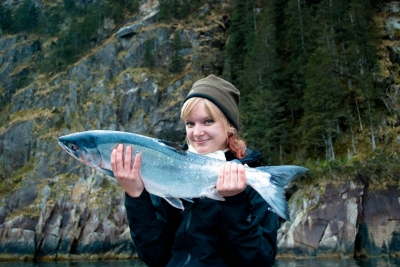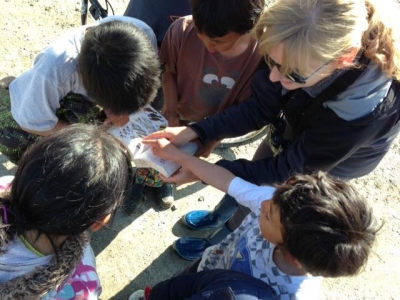Stephanie Smith
Faculty Supervisor: Jim McClelland
Research Expertise: Coastal Ecosystem Dynamics
 Stephanie Smith holds a large Coho salmon, which are a top predator in the Arctic food web.
Stephanie Smith holds a large Coho salmon, which are a top predator in the Arctic food web.
Please tell us a little bit about your research project.
The purpose of my research is to understand the linkages within food webs in the Alaskan Arctic. We use fatty acids and stable isotopes as biomarkers of different primary producers (like land plants, ice algae and diatoms), which are food sources for invertebrates, fish, birds and large mammals. Getting a better handle on the linkages of the food web will help us to understand how the ecosystem operates and to develop tools for tracking changes and predicting the future state of the system as a result of development and climate change.
How did you decide you wanted to pursue marine science?
When I was 12 years old, I went to Sea Camp at Texas A&M University in Galveston and developed a love for marine science. I kept going back every year (3 years total) and then went to college there for my undergraduate degree there.
In 10 years what would you like to have accomplished?
In 10 years, I hope to stay involved in scientific research, but my passions are driving me towards education. I would like to teach and be able to make an impact through public outreach.
What is the most interesting or surprising thing you’ve gotten to do for this project?
The most interesting thing that I’ve done is participating in fieldwork in the Alaskan Arctic and seeing amazing animals like polar bears, caribou and eiders right in front of you. It’s such a unique experience to travel to the Arctic, and most people never get the chance to see it.
What’s been the greatest reward of doing research? The greatest challenge?
The greatest reward is when you finally finish a project and get to present the results at a conference. It’s the big moment when everything comes together. The most challenging part of research is being comfortable with adapting ‘on-the-fly’ changes in your research plan, but that’s when the most learning happens. I like to focus on learning from mistakes and moving forward. (And of course statistics.)
What inspires you?
Teaching 3rd and 4th graders – when I’m educating them about science, and taking them out in the field. To see how excited they are really reaffirms my love of science and inspires me to do more.
 Stephanie teaches students in the Summer Oceanography Program, which is a 5-day adventure based in Kaktovik, Alaska.
Stephanie teaches students in the Summer Oceanography Program, which is a 5-day adventure based in Kaktovik, Alaska.
Why did you choose UTMSI?
I’m a Texas girl at heart and it worked out really well that there was a program in Texas that allowed me to do research in the Arctic. You wouldn’t expect that in South Texas there would be similar interests and opportunities for research in colder climates.
If you were a marine organisms what would you be and why?
I would be an oyster because they can filter gallons and gallons of water a day and clean the environment at the same time. They are also delicious!
Stephanie Smith is a graduate student at The University of Texas Marine Science Institute seeking a masters in science. She has a bachelor of science in marine biology from the Texas A&M University in Galveston and hails from Houston. After graduation this summer, Stephanie will be exploring the job market for exciting and rewarding opportunities where she can put her marine science skills to good use.